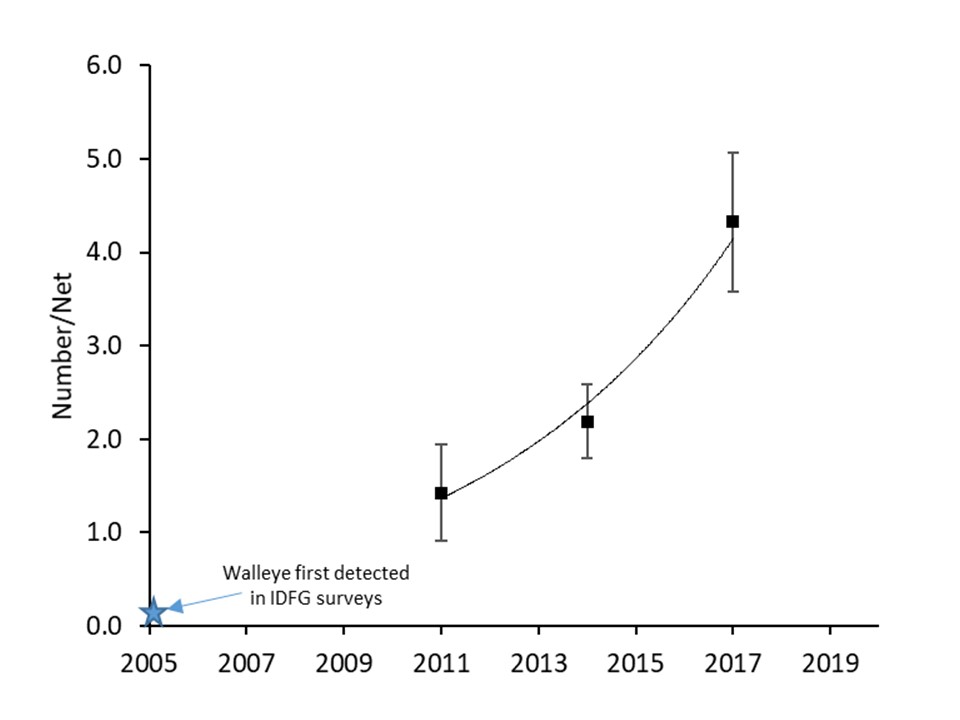
A growing walleye population in Lake Pend Oreille poses a threat the lake’s ecosystem and multi-million dollar recreational fishery. Biologists are concerned that if left unchecked, walleye numbers will continue to increase to the point of collapsing the keystone kokanee population, also hurting growth rates of trophy fish like rainbow trout, bull trout and smallmouth bass.
Walleye were illegally introduced to Noxon Reservior in the early 1990’s and have expanded downstream. As a spiny, non-native fish, they have no natural predators. Studies indicate Pend Oreille walleye feed primarily on kokanee in the deeper parts of the lake and yellow perch in the shallower areas. Their population has been growing exponentially since 2014.

Fish and Game wants to find effective ways to keep walleye at a low enough density that they do not jeopardize the world-class fishery in Lake Pend Oreille. To do this, managers are using lessons learned from of the lake trout suppression program as a model.
Lake trout, also known as mackinaw, are similar to walleye in that they are also a non-native, top predator and popular sportfish from the Midwest. Lake trout nearly collapsed the Pend Oreille kokanee population, which bottomed out in 2007.
Lake trout incentivized angling and gillnetting began in 2006 and has been tremendously successful: kokanee stocks recovered which in turn feed everything from trophy-sized rainbow trout, native bull trout and cutthroat, to bald eagles. The same two suppression techniques continue to operate today with strong public support.
As with lake trout, suppression efforts will not eliminate walleye from the lake: these fish are here to stay. Instead, the goal is to keep their population at a low density. Fish and Game encourages anglers to fish for and harvest walleye. There are no seasons or bag limits and the walleye lottery continues for its second year.
Netting resumes mid-April
Walleye gillnetting operations will run for three weeks this spring, April 13 to May 1. Crews will target spawning walleye in the shallow, northern sections of the lake. Sites will include portions of the Clark Fork Delta near Sheepherder Point, the Pack River Delta and Sunnyside areas, Oden Bay and Kootenai Point
To avoid running into nets, anglers are advised to keep an eye out for large, flagged buoys. Nets can be up to two miles long and are set for four to five hours early in the morning. Nets are set deep enough they won’t affect boating, but anglers should stay away from nets to avoid entangling and losing fishing gear. Tampering with nets is both dangerous and illegal.
Testing suppression to sustain the sport fishery
In 2018, Fish and Game convened a panel of walleye experts from across the U.S. and Canada to help determine just how big a threat walleye were to Lake Pend Oreille fisheries.
“It became very clear that we needed to start testing suppression tools right away. We know from our experience with lake trout that this remarkable fishery can’t support another top-level predator that is left unchecked,” said Matt Corsi, Principal Fisheries Research Biologist.
To evaluate the feasibility of gillnetting to manage walleye, Fish and Game contracted a commercial netting company to operate for three weeks in the spring while walleye were congregated to spawn. A total of 1,233 walleye were caught and removed in the first year of targeted gillnetting. Incidental catch of other species has been low.
“We’ve caught 300 to 400 smallmouth bass, but they are very hardy and all have been released alive. We’ve caught other species, like bull trout, rainbow trout, and cutthroat trout, but mortality has been negligible,” Corsi said.
In 2019, the same approach was repeated. Crews removed 853 walleye.
“Of the walleye we removed in 2019, 420 (49 percent) were adult females, which is an encouraging sign to biologists that abundance can be managed with netting” said Corsi.
To date, over 5,000 pounds of walleye have been donated to Bonner Food Bank and ABC Food Bank as a result of these removals.
“While the number of walleye removed is substantial, it isn’t yet clear if the effort is enough to slow or halt the expansion of the population” said Corsi.
“We’ll learn more about the change in walleye population in the fall, when we complete our fall walleye index survey,” said Regional Fishery Biologist, Rob Ryan. This survey is designed to provide a reliable indication of whether the current levels of netting and angler harvest are sufficient to manage walleye at a low and sustainable abundance.

